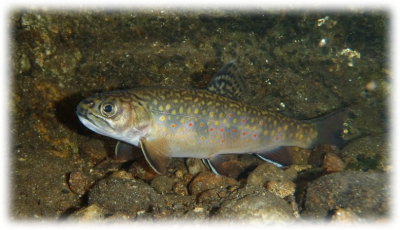
Lucas R. Nathan, Ava. A Smith, Amy B. Welsh, Jason C. Vokoun
Article by: Veronica DeFelice
The brook trout is a species of freshwater fish in the salmon family, Salmonidae. The absence of teeth in the roof of the mouth, their light colored spots on a dark colored body, their reduced scales, and variances in skeletal structure are signature to the Brook Trout. It is native to Eastern North America in the United States and Canada, but has been present elsewhere in North America and to other continents. Essentially relating to the species name “fontinalis,” meaning, “living in springs,” Brook Trout tend to grow larger in larger bodies of water. Likewise, Brook Trout have chiller water temperature necessities than the non-native brown and rainbow trouts.
Lucas Nathan, a current University of Connecticut Ph.D student studying landscape level influences on Brook Trout genetics, along with major advisor Jason Vokoun, wanted to find out and study if culvert, a stream or a channel carrying water, assessments can be an indicator of Brook Trout’s population, and stream, being separated. Road crossings, which do not prioritize fish, are a common origin of stream separation. The article states that, “maintaining connectivity promotes population resilience by increasing diversity in accessible habitat, genetics, and life history strategies.” The goal is to promote natural processes lead by the ecosystems. Barriers only disrupt the movement and can limit access to significant recourses, while increasing the likelihood of eradiation and ultimately discontinuing gene flow.
“In a human dominated system, like we have in Connecticut, it is difficult to maintain connectivity. We need to prioritize what areas are in need of fixing,” said Nathan.
In their study, Brook Trout were sampled from July-September of 2014 and 2015 in headwater streams across Connecticut by use of electrofishing, which is to fish using electrocution. Primarily, a genetic approach was used to determine the extent by which you can use culvert scores to predict surviving genetic differentiation across and above Road Crossing culverts. Secondly, genetic differentiation was assessed and was related to culvert classification. Lastly, genetic patterns were analyzed for an association with the culvert features and characteristics that correlated with those patterns.
Genotypes were measured for the presence of errors. Genomic DNA was taken from 609 individual samples using extraction kits. In addition to the variables being assessed, three other variables included, “watershed area, segment length, and stream slope.”
This study documented the effects of culverts on the genetics of the population of Brook Trout. Results indicated that there is no significant differences between culverts classified as no aquatic organism passage or reduced aquatic organism passage based on any of the four genetic measures. Additionally, there was no significant correlation between NAACC scores and any of the four genetic measures. Culvert openness was the only culvert that has a significant correlation. Overall, culvert dimensions have been recognized as vital component of the route for fish.